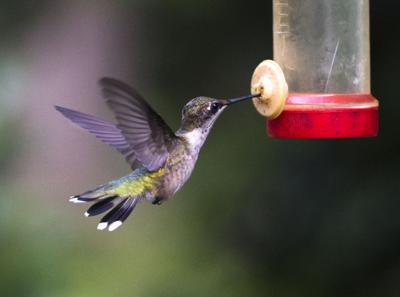Many home gardeners are pivoting towards planting native trees, shrubs and flowers in their yards. These plants are low-maintenance by nature; thrive in South Carolina’s warm, humid climate; attract pollinators like butterflies and bees; and conserve water. These gardens also help create bird-friendly spaces, attracting migratory birds and year-round species — a plus for the growing number of folks who have picked up birdwatching as a hobby in recent years.
So for the birdwatching enthusiast or the environmentalist at heart, here are some ways you can make your backyard and garden a haven for birds to stop over or, if you’re lucky, stay a while. The call of the eastern bluebird, a trio of low-pitched warbles repeated one after the other, filling the air with song. The distinctive thud-thud-thud of a red-bellied woodpecker, chiseling away at the base of a hardy oak or pine.

The deep vibration from the rapidly beating wings of the ruby-throated hummingbird. A painted bunting sits on a tree branch in Summerville. These are the songs you’ll be able to hear when gardening with birds in mind.
Birds are natural pollinators and are attracted to places with ample food and cover. Trees are the “penthouse of the backyard sanctuary,” according to the Clemson Cooperative Extension’s Home and Garden Information Center. If you’ve got space to plant trees, plant ones that will produce an ample canopy cover.
Hardwoods are good options, and there are several that are native to South Carolina, like live oaks or hickories or sweet-gum trees. "Many of them provide important food for birds, like hard and soft acorns, nuts and fruits," said Christy York of Clemson Extension's T.E.
A.C.H.
Center at the Citadel Mall in West Ashley. Hummingbirds are attracted to plants with tubular flowers, like the native coral honeysuckle. Plants that produce fruits and seeds, or support insects like caterpillars or spiders, create favorable conditions for birds to stop by.
American holly, an evergreen tree that can thrive in both full sun and shade, produces bright red berries that birds eat, like northern cardinals, with their rosy plumes, and the colorful painted bunting. Tubular flowering plants and vines, like coral honeysuckle or trumpet creeper, are popular with hummingbirds. Their long, slender beaks are perfect for reaching the nectar found in the center of the flower.
The National Audubon Society, a bird conservation organization with chapters throughout South Carolina, compiles a database of native plants , the birds that benefit from them and where to buy them locally. Garden features like bird baths, boxes and feeders can attract birds, too. Birds enjoy water features like fountains to drink from and bathe in.
It's best to provide several options in your yard or garden to reduce competition between birds looking to take a dip. A baby Eastern bluebird pokes its head out of a birdbox in Charleston. Baths should be cleaned regularly, according to the Audubon Society, to remove old seed and waste, as well as disinfected to prevent diseases.
A weak bleach solution is recommended to properly disinfect bird baths. Hummingbird feeders, the typically brightly colored containers filled with sugary water to mimic a flower's nectar, are commonly hung near windows and used to attract the small birds. While these can be effective in drawing hummingbirds up close to see, feeders can sometimes do more harm than good if improperly maintained.
"It'll make them very sick ...
with a nasty hummingbird feeder, especially when it gets really hot," York said. Feeders should be cleaned at least two to three times a week and every day or every other day during hot weather periods. Adding a bird box to your yard could be beneficial for the eastern bluebird.
The bluebird is a cavity-nesting bird that prefers to build its nest in naturally-occurring spots or ones made by other birds. Jim Sproull with the S.C.
Bluebird Society speaks to members of the community about bluebird boxes during a hands-on training event on monitoring the birds on Feb. 25, 2023, in Summerville. Loss of habitat and competition from non-native birds has made it difficult for the native bluebird to successfully find places to lay its eggs safely, according to the South Carolina Bluebird Society.
Creating wooden bird boxes can encourage bluebirds to nest in your garden or backyard. These are typically made of cedar, redwood, cypress or pine and mounted to a metal or plastic pole to deter predators, with a hole just big enough for a bluebird to slip in and out..
Technology

Build a bird-friendly backyard this spring in Charleston with native plants and bird boxes

Fill your backyard or garden with the iconic songs of South Carolina's native birds by choosing plants and features that attract and support a bird-friendly community this spring.















